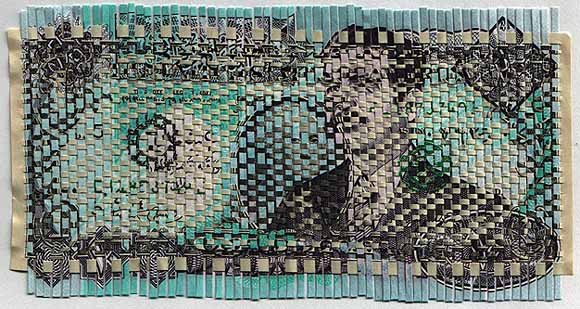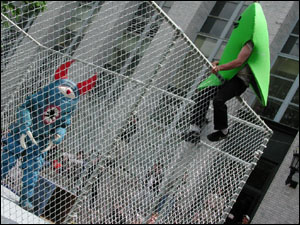View current page
...more recent posts
I'm trying to set up a music studio and it's slow and frustrating as hell. There's a reason I use simple-minded programs in my visual work--I want the tech to be fast and uncomplicated, and then I compensate by doing something ridiculously labor-intensive on the physical end. So far I've had a similar approach to music, somewhat in reverse: using entry level programs and the computer's sound card but mousing in the entire composition note by note on an old fashioned staff. One of my family members said, "Yeah, but it's the same four notes over and over!" I tried to explain that there are timbral variations that make the work similar to my sphere paintings, which this person likes, and exciting octave jumps, and subtle things with syncopation, and...well.
The problem is I'm tired of the textures of the low end music programs and want the sound to get richer. I love the Sidstation synthesizer I bought recently and think it deserves better accompaniment than the sound card synths in the shareware program I downloaded. I'm tired of buzz and hum in the recording. I want better bass and drum sounds. I want a real sequencer.
Before Christmas I bought a sampler from craigslist: an E-mu E6400 Classic. I've been playing with it tonight and it's been fun learning how a 9 year old sampler works but, actually, I'm not sure it does work. I managed to record a 1-second sample but couldn't save it. This machine has no internal hard drive, so my options are to hook a scuzzy (SCSI) cable up to a zip drive or CD ROM, neither of which I have, get an adapter card and enter "Scuzzy Hell" trying to get my PC to read it, or use the floppy drive to store small bits of data. Watching this thing slo-o-owly format a floppy was discouraging, and then I couldn't save to it. After 3 tries I successfully named a "bank," but then the sample wouldn't go in it. Eventually I turned off the machine and lost the sample.

Oriane Stender, Dinars to Dollars (woven dollar bill and 10 dinar note)
David LaChapelle, he of the horrible stagy photographs, has sniffed out the latest ghetto thang: "krumping" or "clown dancing." It sounds intense and fun to watch, as described in Forward Retreat's review of LaChappelle's film documentary on the trend. ("More lyrical than the rock/pop jerks of breakdancing, clowning and krumping involve a level of physicality so intensely rhythmic that one could mistake dance practice for a gang fight. Combining hip hop, breaking, the martial arts and strip dancing techniques--just to point out a few more recognizable influences--young dancers pump their booties like machine gunfire.") The blog then issues a challenge:
Go ahead, let it rip. Scream "cultural appropriation" and run wildly through the halls of the nearest University's Anthropology department. Deride LaChappelle as a slutty Vanity Fair-contracted commercial photographer. Then see Krumped, and prove yourself wrong.Cultural appropriation will likely occur at the MTV, DVD, McDonald's movie tie-in level, given the entertainment industry's inability to produce anything original--this sounds like a natural. Where LaChappelle "bravely" led, others will follow. The challenge perhaps ought to be--how long before white kids in the burbs are doing this? Six months? A year?
I herewith offer a related counter-trend which, lacking the potential for shots of tight youthful buns, will never be as big as krumping: Kaiju Big Battel (sic). From the Boston Phoenix: "Kaiju, which means 'mysterious beast' in Japanese, is a Boston-based monster-wrestling league that stages full-scale matches, contests, and tournaments...[i]nfluenced by Japanese anime, World Championship Wrestling subplots, and the kitsch of dubbed monster-movie cult classics like Ultraman..."
more pics / more Boston Phoenix (hat tip to Kristin for the link.)

UPDATE: T.Whid politely suggests that KBB is old news but I say it's never too late to pose anything as a counter-trend to David LaChappelle.
Fuzzy think piece in the NY Times today here on the Tsunami and what it all means. A good discussion of how cataclysmic seismic events seem to come in clusters lies sandwiched between the contentious headline "The Year the Earth Fought Back" and some spurious riffing on the Gaia hypothesis, which holds that the entire world is a living organism.
The key word there is "living." To imply that the molten rock under our feet is an active (as in volitional) part of Gaia takes us a bit further back into animist mysticism than most of us should want to go. In other words, the headline and thesis might be intuitive if 100,000 had died as a result of disease or sudden release of organic chemicals into the air. That could indeed suggest that Gaia has "fought back" against our sloppy stewardship of her--that she is self-regulating to correct damage one of her component species causes.
Yet surely if Gaia exists it is in the community of living matter hugging an inhospitable ball of nickel-iron like a skin, not the ball itself. The ball's mistreatment of the skin may very well come in peristaltic spurts of volcanos and earthquakes, but the skin adjusts to that over the eons. Rock responds to the biosphere, too, of course, but lightly, in the form of erosion. To say that the biosphere sent a signal to the rocks to deform themselves and punish mankind is Old Testament hogwash--turning a nurturing mother back into the man with the spear.
